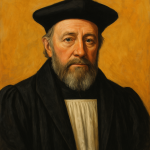
Thomas Cranmer (1489–1556)
Thomas Cranmer was the first Protestant Archbishop of Canterbury and the chief architect of the English Reformation under Henry VIII and Edward VI. A cautious reformer and skilled theologian, Cranmer steered the Church of England away from Rome while carefully balancing political necessity with theological conviction. His most enduring legacy is the Book of Common Prayer (1549, 1552), which shaped English-speaking Protestant worship for centuries. Though he wavered under pressure during Mary I’s reign, Cranmer ultimately died as a martyr, sealing his commitment to the gospel with his final, defiant act of burning the hand that once signed a recantation.
Early Life and Education
Cranmer was born in 1489 in Aslacton, Nottinghamshire. He studied at Jesus College, Cambridge, where he embraced the humanist scholarship of Erasmus and mastered Latin and Greek. He earned his doctorate in divinity in 1526 and joined the Cambridge theological community, which was already stirring with reformist ideas.
His reputation as a thoughtful scholar grew when he suggested to Henry VIII that the King’s controversial marital case against Catherine of Aragon should be settled not in Rome but by consulting universities across Europe. This advice caught Henry’s attention and brought Cranmer into royal service.
Rise to Power and Reform
In 1533, Cranmer was appointed Archbishop of Canterbury. Almost immediately, he presided over the annulment of Henry’s marriage to Catherine, paving the way for Henry’s union with Anne Boleyn and England’s break with papal authority. While Henry remained doctrinally conservative, Cranmer quietly advanced reform: authorizing an English Bible in every parish, promoting justification by faith, and fostering the circulation of Protestant writings.
Under Edward VI (1547–1553), Cranmer’s reforms flourished. He produced the Book of Common Prayer (1549, revised in 1552), which replaced the Latin liturgy with English worship rooted in Scripture and Protestant theology. Cranmer emphasized the preaching of the Word, simplified ceremonies, and redefined the sacraments as means of faith rather than mechanical rites. His Forty-Two Articles (1553) outlined the doctrinal foundation of the reformed Church of England.
Theology and Worship
Cranmer’s theology bore the marks of both Lutheran and Reformed influences, but he leaned increasingly toward the continental Reformed tradition in his later years. His vision of worship combined biblical depth with pastoral sensitivity. The Book of Common Prayer is celebrated not only for its theology but also for its literary beauty—its prayers and collects shaped the devotional life of English Protestants for generations.
Cranmer rejected transubstantiation and affirmed that Christ is received spiritually, by faith, in the Lord’s Supper. His sacramental theology echoed Zwingli and Calvin more than Luther, emphasizing remembrance, faith, and the unity of believers. He sought a liturgy that would both catechize the people and draw them into heartfelt worship centered on Scripture.
Downfall and Martyrdom
Cranmer’s fortunes reversed when Mary I came to the throne in 1553, determined to restore Catholicism. He was imprisoned, tried for treason and heresy, and pressured into signing several recantations. Yet when brought to St. Mary’s Church in Oxford in 1556, Cranmer dramatically reversed himself. He declared his earlier recantations false, proclaimed the supremacy of Scripture, and denounced the papacy.
As he was led to the stake, Cranmer thrust his right hand into the fire first, crying, “This hand hath offended.” He died at age 66, leaving behind the memory of a reformer who struggled with compromise but ended in courageous fidelity.
Legacy
Cranmer’s influence endures in Anglican and Protestant worship worldwide. His Book of Common Prayer became a devotional classic, shaping not only Anglican liturgy but also Reformed and evangelical piety through its cadences, collects, and biblical focus. His martyrdom inspired English Protestants during the Marian persecutions and established him as one of the great figures of the Reformation. Though often remembered as a cautious and political churchman, Cranmer’s lasting contribution was a vision of worship rooted in Scripture, reverence, and the grace of Christ.
Books on Thomas Cranmer
Thomas Cranmer: A Life
By Diarmaid MacCulloch (1996)
The definitive scholarly biography, richly detailed and balanced in its treatment of Cranmer’s complex character and theological development.Thomas Cranmer
By Jasper Ridley (1962)
A readable and engaging account of Cranmer’s life and role in the English Reformation.Cranmer: Archbishop of Canterbury
By Charles C. Butterworth (1964)
A sympathetic Protestant biography focusing on Cranmer’s reforms and struggles.Cranmer’s Godly Order: The Destruction of Catholicism and the Building of Protestantism in England, 1547–1553
By John T. McNeill (1948)
Classic study of the liturgical and theological transformation Cranmer initiated.The Book of Common Prayer: A Biography
By Alan Jacobs (2013)
Traces the history, influence, and ongoing relevance of Cranmer’s greatest legacy.The Reformation: A History
By Diarmaid MacCulloch (2003)
A sweeping history of the Reformation with important sections on Cranmer and the English church.The Collects of Thomas Cranmer
By C. Frederick Barbee and Paul F. M. Zahl (2006)
Examines the theological richness and enduring beauty of Cranmer’s prayer book collects.Thomas Cranmer’s Doctrine of Repentance: Renewing the Power to Love
By Ashley Null (2000)
An in-depth theological study on Cranmer’s views of repentance, grace, and spiritual transformation.

